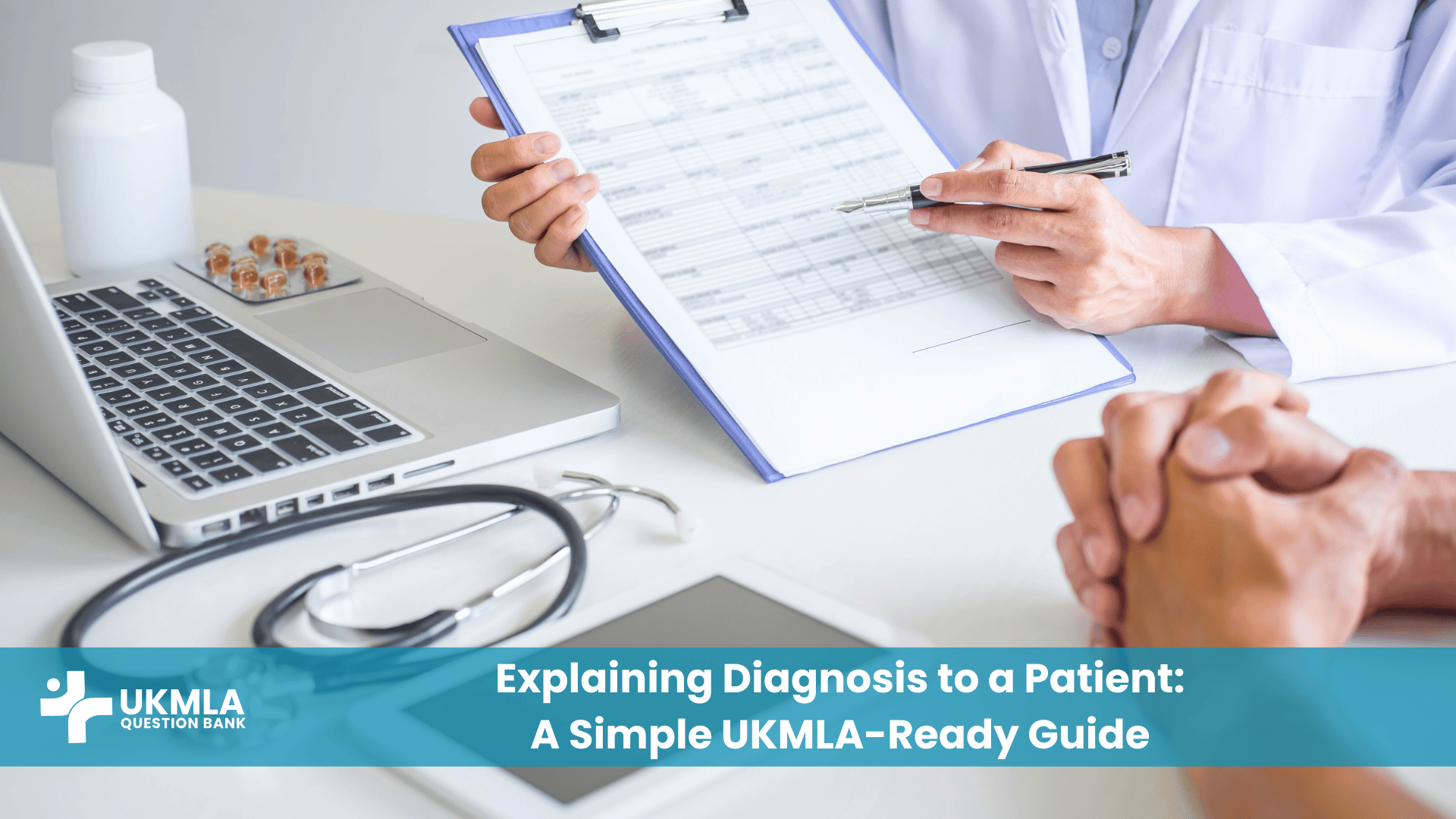Introduction
As a medical student, you’ve spent years learning how to reach a diagnosis. But the skill of explaining diagnosis cpsa is arguably more challenging—and more crucial—than the diagnosis itself. The UKMLA Clinical and Professional Skills Assessment (CPSA) places immense importance on your ability to communicate with empathy, clarity, and compassion. This is not just about reciting a medical term; it’s about translating complex scientific information into a language your patient can understand, building trust, and empowering them to be an active participant in their own healthcare journey.
The reality of the exam is simple: a high-scoring station isn’t about how much you know, but how well you can convey what you know to a real person who is likely scared, confused, or worried. This comprehensive guide will walk you through the essential principles and practical steps for mastering this core competency. We will explore the proven frameworks that will help you structure your thoughts and delivery, anticipate common challenges, and ultimately, score top marks in your communication stations. More importantly, you will be learning a skill that will define you as a compassionate and effective clinician.
Table of Contents
ToggleThe Core Principles of Patient Communication
Before you even begin to speak, a successful consultation starts with a foundation of patient-centred care. The key to this is a structured, empathetic approach that puts the patient’s needs and emotions first. The following frameworks will help you organise your thoughts and deliver a clear, compassionate message that resonates.
The “TIPS” Framework
Think of this as a simple mnemonic to ensure you cover all your bases during a consultation. It’s an easy way to remember the key steps to a great patient conversation.
T – Timing & Setting: This is often overlooked, but it’s vital. Never deliver a diagnosis in a rushed, chaotic, or public environment like a busy corridor or a bedside with curtains half-drawn. Ensure you have a private space where the patient feels comfortable and a moment where you won’t be interrupted. Consider asking, “Is this a good time to talk?” to check in with the patient’s readiness.
I – Information Gathering: This is a crucial, often overlooked step. Before you share, ask. Start by asking the patient what they already know or what their understanding is. Ask questions like, “What have you been told so far?” or “What are your main concerns right now?” This simple act gauges their baseline knowledge, helps you address their most pressing fears, and allows you to tailor your explanation to their level of understanding. For the communication station, a thorough clinical examination is key to gathering all the information you need, so brush up on your skills by reading our guide to Mastering Clinical Examinations for the UKMLA: A Step-by-Step Guide.
P – Pacing & Chunking: Avoid overwhelming the patient with a deluge of information. Deliver the diagnosis and subsequent information in small, digestible “chunks.” After each chunk, pause and check for understanding. Ask simple questions like, “Does that make sense so far?” or “Would you like me to repeat anything?” This ensures the patient is following you and gives them an opportunity to ask questions.
S – Sympathy & Support: Use empathetic language throughout the conversation. Phrases like, “I can see this is difficult news to hear,” or “We’re here to help you through this,” show that you acknowledge their emotional response and are a partner in their care. This builds a therapeutic alliance and fosters trust.
The “ICE” Model (Ideas, Concerns, Expectations) is another fundamental communication tool. It’s an easy way to explore the patient’s perspective and ensure you address their most pressing questions. Before you launch into your explanation, briefly ask about their Ideas about what might be going on, their Concerns about the diagnosis or treatment, and their Expectations for the outcome.
The Step-by-Step Approach for Explaining a Diagnosis
This is a practical, five-step method you can use in any UKMLA communication station. It provides a logical flow and ensures you hit all the key points the markers are looking for.
Step 1: Introduction & Rapport
Start with a warm, genuine greeting. Introduce yourself and your role, and ensure you have the right patient. A simple, “Hello Mr. Smith, thanks for coming in. My name is [Your Name], and I’m one of the doctors here. Please take a seat,” sets a positive and professional tone. This initial rapport-building is a key part of the UKMLA mark scheme. The first minute of your consultation sets the stage for the entire interaction.
Step 2: The “Warning Shot”
Before you deliver the news, prepare the patient for what’s to come. This prevents them from being taken by surprise and gives them a moment to mentally prepare. A good lead-in sentence could be: “I’ve received the results of your tests, and I’d like to talk to you about what we’ve found. Unfortunately, it’s not the news we were hoping for.” This gives them a moment to brace themselves before you deliver the news.
Step 3: Breaking the News (The Diagnosis)
This is the central part of the consultation. Your delivery here is paramount.
Be direct and clear: State the diagnosis simply and without any medical jargon. For example, instead of saying, “You have an exacerbation of chronic obstructive pulmonary disease,” you should say, “The results show that your lungs are struggling a bit, and you have a condition called COPD, which has gotten worse.”
The ‘Lump of Coal’ Analogy: A simple, yet effective analogy. Think of the diagnosis as a lump of coal. It’s heavy and difficult to handle. Get it out of the way first. Don’t hide it or sugar-coat it. Once you’ve delivered the diagnosis, you can then add the lighter, more hopeful information about treatment and prognosis. Delivering the diagnosis directly allows you to then focus on the patient’s reaction and provide support.
Step 4: Providing Information & Answering Questions
Once the diagnosis has been delivered, the patient will likely have a cascade of questions. The “What, Why, and What Now?” framework is perfect for providing a comprehensive and structured overview.
What is it? Provide a simple, clear explanation of the diagnosis. Use analogies if they are helpful, such as comparing a blocked artery to a clogged pipe.
Why did it happen? Explain the cause or aetiology in a way they can understand. Was it genetic? A lifestyle factor? An infection? Be honest and avoid assigning blame.
What now? This is the most important part—the treatment plan. Discuss the next steps, including investigations, a management plan, and follow-up. While discussing these plans, you may need to explain blood test results; our article, The Ultimate Guide to UK Blood Tests and Lab Values for the UKMLA, can help.
Step 5: Planning the Next Steps
This is where you make the consultation a collaborative effort. Discuss the treatment options, involving the patient in the decision-making process. Ensure they understand the pros and cons of each option. Provide a “safety net” by giving them a patient information leaflet (you can find examples on the NHS website), the name of a key contact (e.g., a specialist nurse), and arranging a follow-up appointment. This ensures they don’t leave the consultation feeling lost or unsupported.
Navigating Common Communication Challenges in the CPSA
The UKMLA will test you on more than just a standard consultation. Here’s how to handle some of the trickier scenarios that might come up.
Communicating with Relatives and Carers: If a family member is present, ensure you have the patient’s explicit consent to share information. Address both the patient and the relative, and check in with both regularly. Remember that the patient is the central figure in the consultation.
Dealing with Emotional Reactions: It is not uncommon for a patient to become angry, upset, or tearful. In these situations, your best tool is silence. Pause and allow them space to react. Offer a tissue and a moment to compose themselves. Avoid saying, “Don’t cry.” Instead, use empathetic phrases like, “I can see this is difficult to hear.” Your ability to remain calm and supportive will score you high marks. You can also draw on some of the core concepts of psychiatry to understand and manage these difficult conversations. For a great overview, check out our guide to Master High-Yield Psychiatry for UKMLA: 7 Key Topics.
When You Don’t Have an Answer: You won’t know everything, and that’s okay. What’s not okay is making something up. Be honest and humble. A good response is, “That’s an excellent question, and I don’t have the answer right now, but I will speak to a senior colleague, and we will get back to you with more information as soon as we can.” This demonstrates integrity and builds trust.
The Anatomy of a High-Scoring UKMLA Station
To truly excel, you need to understand the marking scheme. Markers are looking for a few key things that demonstrate both your medical knowledge and your professional competence. It’s a key part of your medical professionalism, which is outlined in the GMC’s “Good Medical Practice” guidance.
Table 1: The 5-Part UKMLA Mark Scheme for Explaining a Diagnosis
| Aspect | What the Marker is Looking For |
|---|---|
| Establishes Rapport | A warm, professional, and empathetic tone from the outset. Does the candidate listen actively and use open body language? |
| Explains Diagnosis Clearly | Uses simple, non-jargon language. Explains the “what,” “why,” and “what now.” Does the candidate check for understanding? |
| Patient-Centred Approach | Asks about the patient’s ideas, concerns, and expectations (ICE). Does the candidate address these directly? |
| Shared Decision-Making | Involves the patient in the treatment plan. Discusses options and next steps, respecting the patient’s autonomy and values. |
| Manages the Consultation | Paces the conversation effectively. Provides a safety net and clear follow-up plan. Does the candidate handle emotional responses appropriately? |
Frequently Asked Questions (FAQ) about Explaining a Diagnosis
While many factors contribute to a good consultation, the single most important thing to remember is to prioritize clarity and empathy. Remember that this is likely the first time the patient has heard this diagnosis, and their reaction will be emotional. Your job is to be a clear, compassionate guide.
A “warning shot” is a brief sentence or two that prepares the patient for difficult news. It prevents them from being blindsided and gives them a moment to brace themselves for what you are about to say.
No. Avoid medical jargon at all costs. If you must use a medical term that has no simple alternative, follow it immediately with a simple, layperson’s explanation. For example, “This is a benign tumour, which means it is a growth that is not cancerous.”
Your most powerful tool here is silence. Pause and be silent. Offer a tissue and allow them to process their emotions. Acknowledge their feelings with an empathetic statement like, “I can see this is difficult.” Your ability to remain calm and non-judgmental will build immense trust.
The best way to build confidence is through deliberate practice. Practice with a friend, a peer, or a family member. Have them play the role of a patient and give you feedback on your clarity and tone. You can also use high-quality UKMLA-style questions to apply your knowledge to clinical scenarios. For a great overview of other high-yield topics, check out our guide to Paediatrics Essentials for UKMLA: High-Yield Conditions & Child Health Management.
Be honest, but be realistic and compassionate. Avoid giving false hope. Use phrases like, “The prognosis depends on many factors, but our goal is to…” and then explain the treatment plan. This focuses on what you can control together.
Yes, always. A patient will likely be overwhelmed with information, so a physical leaflet or a link to an official NHS website will give them a reliable resource to refer to later. This is an important part of your “safety net.”
Be honest and professional. Tell the patient you don’t know but will find out and get back to them. This demonstrates integrity and builds trust, proving you are a reliable professional.
Start with a warm welcome and an open, non-judgmental stance. Active listening and asking open-ended questions are great ways to build rapport quickly. Show genuine interest in the patient as a person, not just a list of symptoms.
Shared decision-making is the process of a patient and doctor making a healthcare decision together. It’s about presenting options and allowing the patient to choose what is right for them, taking their values and preferences into account. It’s a key part of modern medical practice.
Conclusion
Mastering the art of explaining diagnosis cpsa is a fundamental milestone in your medical career. It’s the moment when your years of scientific knowledge are put into compassionate, human-centred practice. The UKMLA assesses this not just as a communication exercise, but as a core tenet of what it means to be a good doctor.
By following the principles outlined in this guide—from the “TIPS” framework to using clear, jargon-free language—you are not just preparing for an exam. You are preparing to be a clinician who can truly connect with patients, ease their fears, and guide them through a difficult time. This is a skill that will serve you throughout your career, building trust and making a tangible difference in the lives of your future patients.



